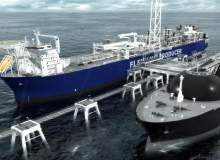
Gulf LNG project includes the development of the onshore Elk and Antelope gas and condensate fields in the Gulf Province of Papua New Guinea. Gas produced from these fields is proposed to be liquefied by a floating LNG (FLNG) vessel and exported.
The project is being jointly developed by InterOil and Pacific LNG Operations. The two companies have established a new entity called Liquid Niugini Gas to build and operate the project. InterOil owns 52.5% stake in the company and Pacific LNG owns the remaining 47.5%.
The project was approved by the National Executive Council of Papua New Guinea in December 2009.
Generic Front-End Engineering and Design (FEED) for the project was completed in 2009. Project specific FEED is currently ongoing.
A final investment decision on the project is expected to be made by the end of 2011. An investment of $6bn is expected to be made by the partners.
Production capacity of the project will be 7.6-10.6 million tons per annum (mtpa). The project is scheduled to commence operations in 2014 with an initial capacity of 5mtpa.
Construction and infrastructure of the Gulf LNG project
The project is divided into upstream and midstream. Upstream facilities will include seven to nine production wells, one water re-injection well, condensate stripping plant (CSP) and condensate pipeline.
The CSP will include four trains with a capacity of 450 million standard cubic feet a day (mmscfpd). It will be built by a 50-50 joint venture with Mitsui at a cost of $550m. A produced water re-injection pipeline will also be part of the plant to re-inject water into the injection well.
Under the JV agreement, Mitsui has the option to purchase 5% interest in the Elk and Antelope fields and in the LNG project. The government of New Papua Guinea through its nominee Petromin PNG Holdings will have the right to acquire 22.5% interest in the plant.
A 120km condensate pipeline with a diameter of 12in will carry the condensate from the CSP to storage tanks located on the Gulf province.
Upstream facilities also include a condensate recovery pipeline from the liquefaction facilities to carry condensate to the storage tanks. Another pipeline will connect the storage tanks with the condensate ship loading facilities.
Midstream facilities of the project include a dry gas pipeline, land and floating liquefaction facilities, storage tanks and export terminal facilities.
Land-based liquefaction facilities will include a 3mtpa modular LNG plant expandable up to 8mtpa.
The plant will be financed by the Energy World Corporation (EWC) in exchange for 14.5% of the proceeds from the sale of LNG.
The 2mtpa FLNG vessel forms the floating liquefaction facilities of the project. FLEX LNG and Samsung Heavy Industries will finance, construct and commission the FLNG vessel. FLEX LNG will operate the vessel along with Liquid Niugini Gas.
The export terminal facilities of the project include a 6km breakwater facility, causeway, jetty, wharves and mooring facilities for LNG vessels. Offices, warehouses and accommodation facilities are also part of the infrastructure.
Gas and condensate produced at the Elk and Antelope fields will be processed at the CSP and transported through the condensate pipeline to the liquefaction facilities.The gas will be exported after liquefaction.
Resources and reserves at the Elk and Antelope gas and condensate fields
The Elk field was discovered in 2006 and the Antelope field in 2008. The fields are estimated to contain recoverable reserves of 8.59 trillion cubic feet (tcf) of gas and 128.9 million barrels of condensate. Flow tests at the Antelope field indicated high productivity rates of 300mmcfpd. Carbon dioxide content in the reserves is around 5-6%.
Supply contracts awarded
In August 2011, InterOil and Pacific LNG signed an agreement with Noble Clean Fuels to supply 1mtpa of LNG from the Gulf LNG project. The agreement has been signed for a period of ten years commencing from the project start date of 2014.
Another 0.3mtpa will be supplied to EWC for its Philippines power project. Negotiations are underway for offtake of the remaining volumes of LNG.

